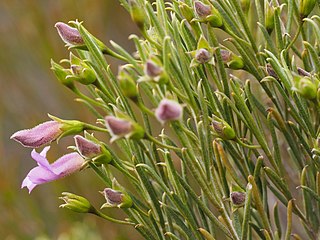
Eremophila flabellata is a flowering plant in the figwort family, Scrophulariaceae and is endemic to Western Australia. It is a small shrub with serrated leaves, broad serrated sepals and pink, purple or mauve flowers.
Eremophila grandiflora is a flowering plant in the figwort family, Scrophulariaceae and is endemic to Western Australia. It is a large shrub with shiny leaves and the largest flowers in its genus and is only known from a restricted area near Paynes Find.

Eremophila incisa is a flowering plant in the figwort family, Scrophulariaceae and is endemic to Western Australia. It is a low shrub with shiny leaves which have thickened teeth along their edges and hairy, mauve or purple flowers.

Eremophila labrosa is a flowering plant in the figwort family, Scrophulariaceae and is endemic to Western Australia. It is a shrub with many hairy branches arising from near ground level, narrow, hooked leaves and mauve and blue flowers.
Eremophila oblonga is a flowering plant in the figwort family, Scrophulariaceae and is endemic to Western Australia. It is a small, domed-shaped shrub with small, fleshy leaves and purple or mauve flowers growing near Balladonia.
Eremophila papillata is a flowering plant in the figwort family, Scrophulariaceae and is endemic to Western Australia. It is an erect, compact shrub with sticky, narrow leaves and mauve, blue or purple, rarely white flowers.
Eremophila pendulina is a flowering plant in the figwort family, Scrophulariaceae and is endemic to Western Australia. It is a tall, spindly, weeping shrub with narrow leaves and purple, mauve or white flowers in autumn and early spring.
Eremophila praecox is a flowering plant in the figwort family, Scrophulariaceae and is endemic to Australia. It is a small, broom-like shrub with small leaves and purple and white flowers.

Eremophila rugosa is a flowering plant in the figwort family, Scrophulariaceae and is endemic to Western Australia. It is an erect shrub with sticky, shiny leaves and pink, purple or mauve flowers.

Eremophila spectabilis, commonly known as showy poverty bush, is a flowering plant in the figwort family, Scrophulariaceae and is endemic to Western Australia. It is a dense, erect shrub with narrow, greyish leaves and blue, mauve or purple flowers.
Eremophila succinea is a flowering plant in the figwort family, Scrophulariaceae and is endemic to Western Australia. It is an erect, broom-shaped shrub with sticky, narrow, hooked leaves, narrow, sticky sepals and hairy, pale purple or mauve petals.

Eremophila ternifolia, commonly known as Wongan eremophila is a flowering plant in the figwort family, Scrophulariaceae and is endemic to Western Australia. It is a low, many-branched, shrub with short, pointed leaves and small lilac-coloured or mauve flowers.
Eremophila viscimarginata is a flowering plant in the figwort family, Scrophulariaceae and is endemic to Western Australia. It is a small, erect, prickly shrub with hairy stems, small leaves, greenish-pink sepals and mauve petals.
Eremophila ballythunnensis is a flowering plant in the figwort family, Scrophulariaceae and is endemic to Western Australia. It is a small, spreading shrub with narrow oval leaves and mauve-purple flowers with densely hairy sepals.
Eremophila capricornica is a flowering plant in the figwort family, Scrophulariaceae and is endemic to Western Australia. It is a small shrub with woolly branches, grey, hairy leaves and mauve to lilac-coloured flowers with hairy sepals.
Eremophila daddii is a flowering plant in the figwort family, Scrophulariaceae and is endemic to Western Australia. It is a large shrub with sticky branches, hairy leaves and brown and cream-coloured flowers blotched with purple.
Eremophila jamesiorum is a flowering plant in the figwort family, Scrophulariaceae and is endemic to Western Australia. It is a wispy, sticky shrub with narrow linear leaves and white flowers tinged with pink or mauve. It is only known from a few locations in the Gibson Desert.
Eremophila pusilliflora is a flowering plant in the figwort family, Scrophulariaceae and is endemic to Western Australia. It is a low, open shrub with narrow egg-shaped leaves and flowers which vary in colour from red to cream with a red tinge. It grows in the Pilbara region.
Eremophila laccata is a flowering plant in the figwort family, Scrophulariaceae and is endemic to an area near Carnegie in Western Australia. It is a small, low, spindly shrub with scattered, linear leaves, and pink, flattened bell-shaped flowers.
Eremophila resiliens is a low-growing shrub with deep reddish purple flowers, woolly hairy leaves and that is endemic to Western Australia. It grows on slopes and breakaways near Lake Carnegie.







